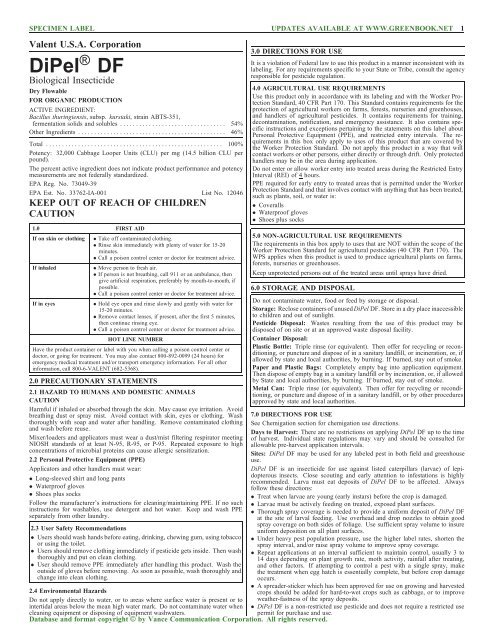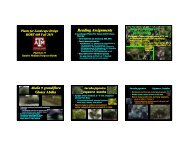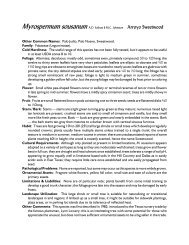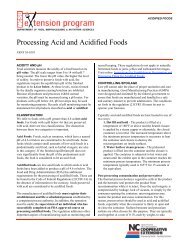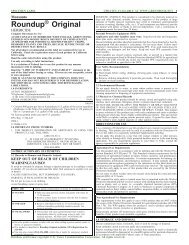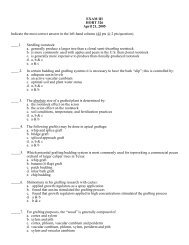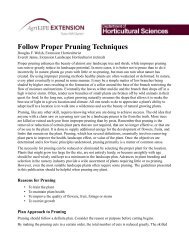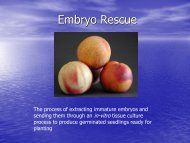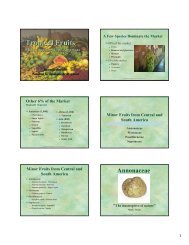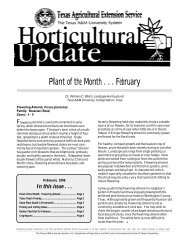DiPel DF - Aggie Horticulture
DiPel DF - Aggie Horticulture
DiPel DF - Aggie Horticulture
- No tags were found...
You also want an ePaper? Increase the reach of your titles
YUMPU automatically turns print PDFs into web optimized ePapers that Google loves.
SPECIMEN LABEL UPDATES AVAILABLE AT WWW.GREENBOOK.NET 2• <strong>DiPel</strong> <strong>DF</strong> may be tank mixed with other labeled insecticides to enhance control.Use of the resulting tank mix must be in accordance with the more restrictivelabel limitations and precautions. No dosage rates should be exceeded. Thisproduct cannot be mixed with any product containing a label prohibition againstsuch mixing. Before tank mixing <strong>DiPel</strong> <strong>DF</strong> with other labeled products, includingspreader stickers, check for tank mix compatibility.After ingesting a lethal dose of <strong>DiPel</strong> <strong>DF</strong>, larvae stop feeding within the hour, andwill die within several hours to 3 days. Mortality varies with larval size (instar),lepidopteran species, and dose consumed. Following ingestion, larvae becomesluggish, discolor, then shrivel, blacken and die. Smaller larvae die more quickly.<strong>DiPel</strong> <strong>DF</strong> may be applied in conventional ground or aerial equipment with quantitiesof water sufficient to provide uniform coverage of infested plant parts. Thevolume of water needed per acre will depend on crop development, relative humidity,spray equipment, and local experience. Usually, selection of moderate tohigh spray volume will provide the best results in most equipment. For optimalresults, use at least 3 gallons of water per acre by air; except in arid areas, where5 to 10 gallons are required. Add water to the mix tank and provide moderate agitation.With agitating, add the required amount of <strong>DiPel</strong> <strong>DF</strong>. Continue agitation,and add other spray materials, if any. Add remaining water, if any, and agitateuntil fully mixed. Maintain the suspension with moderate agitation while loadingand spraying. Do not mix more <strong>DiPel</strong> <strong>DF</strong> than can be used in a 3-day period.Avoiding spray drift at the application site is the responsibility of the applicator.The interaction of many equipment-and-weather-related factors determinethe potential for spray drift. The applicator and the grower are responsible forconsidering all of these factors when making decisions.For Smaller Spray Volumes:If Rate isUse This Amount Per Gallon (wt)1/ 4 lb./acre or 100 gals.1/ 2 tsp. (0.04 oz.)1/ 2 lb./acre or 100 gals.1 tsp. (0.08 oz.)1 lb./acre or 100 gals.2 tsps. (0.16 oz.)2 lb./acre or 100 gals.4 tsps. (0.32 oz.)8.0 CHEMIGATION USE DIRECTIONSApply this product only through sprinkler including center pivot, lateral move, endtow, side (wheel) roll, traveler, big gun, solid set, or hand move irrigation systems.Do not apply this product through any other type of irrigation systems. Do notconnect an irrigation system (including greenhouse systems) used for pesticideapplications to a public water system.8.1 Spray PreparationFirst prepare a suspension of <strong>DiPel</strong> <strong>DF</strong> in a mix tank. Fill tank with 1 / 2 to 3 / 4the desired amount of water. Start mechanical or hydraulic agitation. Add therequired amount of <strong>DiPel</strong> <strong>DF</strong>, and then the remaining volume of water. Then setthe sprinkler to deliver a minimum of 0.1 to 0.3 inch of water per acre. Startsprinkler and uniformly inject the suspension of <strong>DiPel</strong> <strong>DF</strong> into the irrigation waterline so as to deliver the desired rate per acre. The suspension of <strong>DiPel</strong> <strong>DF</strong> shouldbe injected with a positive displacement pump into the main line ahead of a rightangle turn to insure adequate mixing. Any questions on calibration should bedirected to your State Extension Service Specialists, to equipment manufacturersor other experts.NOTE: When treatment with <strong>DiPel</strong> <strong>DF</strong> has been completed, further field irrigationover the treated area should be avoided for 24 to 48 hours to prevent washing thematerial off the crop.9.0 GENERAL PRECAUTIONS FOR APPLICATIONS THROUGH SPRIN-KLER IRRIGATION SYSTEMSMaintain continuous agitation in the mix tank during mixing and application toinsure a uniform suspension.Greater accuracy in calibration and distribution will be achieved by injecting alarger volume for a more dilute solution per unit time.Crop injury, lack of effectiveness, or illegal residues in the crop can result fromnon-uniform distribution of treated water. A person knowledgeable of the chemigationsystem and responsible for its operation, or under the supervision of theresponsible person, shall shut the system down and make necessary adjustmentsshould the need arise. Allow sufficient time for pesticide to be flushed throughall lines and all nozzles before turning off irrigation water.The system must contain a functional check valve, vacuum relief valve, and lowpressure drain appropriately located on the irrigation pipeline to prevent watersource contamination from backflow.The pesticide injection pipeline must contain a functional, automatic, quick-closingcheck valve to prevent the flow of fluid back toward the injection pump.The pesticide injection pipeline must also contain a functional, normally closed,solenoid-operated valve located on the intake side of the injection pump andconnected to the system interlock to prevent fluid from being withdrawn from thesupply tank when the irrigation system is either automatically or manually shutdown.The system must contain functional interlocking controls to automatically shut offthe pesticide injection pump when the water pump motor stops.The irrigation line or water pump must include a functional pressure switch whichwill stop the water pump motor when the water pressure decreases to the pointwhere pesticide distribution is adversely affected.Systems must use a metering pump, such as a positive displacement injectionpump (e.g., diaphragm pump) effectively designed and constructed of materialsthat are compatible with pesticides and capable of being fitted with a systeminterlock. Do not apply when wind speed favors drift beyond the area intendedfor treatment.Do not apply when wind speed favors drift, when system connections or fittingsleak, when nozzles do not provide uniform distribution or when lines containingthe product must be dismantled and drained.10.0 APPLICATION RATE10.1 <strong>DiPel</strong> <strong>DF</strong> for Miscellaneous Crop GroupsCrop Group (Miscellaneous) Pest Pounds/AcreAlfalfa(HayandSeed),Hayand Other Forage CropsLooperAlfalfa Caterpillar1/ 2-11/ 2-1European Skipper1/ 2-1(Essex Skipper)Armyworm 1 1-2Berries and Small Fruit suchas Grape, Strawberry, andBlackberryBulb such as Leek, Garlic andOnion (green and bulb)Cucurbit Vegetables such asMelon, Cucumber and SquashFruiting Vegetables such asTomato, Pepper and EggplantGreenhouse/Shadehouse andOutdoor Nursery Crops suchas Leafy, Herbs, Brassica andFruiting groupsHerbs, Spices and Mintssuch as Basil, Chive, Dill andPeppermintLeafy and Cole Crops suchas Lettuce (head and leaf),Kale, Celery, Spinach, Broccoli,Cabbage, Mustard Greens,Brussels Sprouts, Cauliflower,Collard, Chinese Cabbage,Endive, Kohlrabi and ParsleyLegume Vegetables such asBean, Pea, Lentil and SoybeanDatabase and format copyright © by Vance Communication Corporation. All rights reserved.Grapeleaf Skeletonizer(ground only)Grape LeafrollerAchema Sphinx Moth(Hornworm)Saltmarsh Caterpillar(ground only)Omnivorous Leafroller1/ 2-11/ 2-11/ 2-11/ 2-11/ 2-1(ground only)Looper 1/ 2-1Orange Tortrix 1/ 2-1Oblique Banded Leafroller 1/ 2-1Armyworm 1 1-2Tobacco Budworm 1/ 2-2Grape Berry Moth 1/ 2-1Melonworm 1/ 2-1Cutworm 1/ 2-1Cranberry Fruitworm 1-2Cherry Fruitworm 1-2Gypsy Moth 1/ 2-2LooperOmnivorous Leafroller1/ 2-11/ 2-1Hornworm 1/ 2-1Imported Cabbageworm 1/ 2-1Diamondback Moth 1 1/ 2-1Green Cloverworm 1/ 2-1Webworm 1/ 2-1Saltmarsh Caterpillar 1/ 2-1Armyworm 1 1-2Cutworm 1/ 2-1Cross-striped Cabbageworm 1/ 2-1Heliothis 1/ 2-2LooperMelonworm1/ 2-11/ 2-1Rindworm Complex 1/ 2-1Armyworm 1 1-2LooperHornworm1/ 2-11/ 2-1Tomato Fruitworm 1/ 2-1Variegated Cutworm 1/ 2-1Saltmarsh Caterpillar 1/ 2-1Armyworm 1 1-2LooperHeliothis1/ 2-11/ 2-21/ LooperArmyworm 1 1-2Saltmarsh Caterpillar2-11/ 2-1LooperOmnivorous LeafrollerHornwormImported CabbagewormDiamondback Moth 1Green CloverwormWebwormSaltmarsh Caterpillar1/ 2-11/ 2-11/ 2-11/ 2-11/ 2-11/ 2-11/ 2-11/ 2-1Armyworm 1 1-2Cutworm 1/ 2-1Cross-striped Cabbageworm 1/ 2-1Heliothis 1/ 2-2LooperSoybean Looper1/ 2-11/ 2-1Green Cloverworm 1/ 2-1Velvetbean Caterpillar 1/ 2-1Armyworm 1 1-2
SPECIMEN LABEL UPDATES AVAILABLE AT WWW.GREENBOOK.NET 3Crop Group (Miscellaneous) Pest Pounds/AcreRoot and Tuber such as Carrot,Potato, Beet and Sugar BeetPodworm 1/ 2-1LooperOmnivorous Leafroller1/ 2-11/ 2-1Hornworm 1/ 2-1Imported Cabbageworm 1/ 2-1Diamondback Moth 1 1/ 2-1Green Cloverworm 1/ 2-1Webworm 1/ 2-1Saltmarsh Caterpillar 1/ 2-1Armyworm 1 1-2Cutworm 1/ 2-1Cross-striped Cabbageworm 1/ 2-1Heliothis 1/ 2-2Crop Group (Other Crops) Pest Pounds/AcrePineappleGummosos-Batrachedra Comosae1/ 4- 1 / 2(Hodges)Thecla-Thecla Basilides (Geyr) 1/ 4- 1 / 2Rape (Canola) Looper 1/ 2-1Armyworm 1 1-2Heliothis 1/ 2-2Safflower Looper 1/ 2-1Saltmarsh Caterpillar 1/ 2-1Armyworm 1 1-2Sunflower (Ground applicationonly)LooperHead Moth1/ 2-11/ 2-1Stone Fruit such as Cherry,Plum, Peach, Prune, andNectarinePome Fruit such as Apple andPearTree Nuts such as Almond,Pecan, Walnut and FilbertPomegranateSmall Grains (Groundapplication only)Redhumped Caterpillar1/ 2-2Tent Caterpillar1/ 2-2Omnivorous Leafroller1/ 2-2Fall Webworm 1/ 2-2Walnut CaterpillarCankerwormGypsy MothVariegated LeafrollerRedbanded Leafroller1/ 2-21/ 2-21/ 2-21/ 2-21/ 2-2Tufted Apple Budmoth 1/ 2-2Fruittree Leafroller 1/ 2-2Oriental Fruit Moth 1/ 2-2Cutworm 1/ 2-2Filbert Leafroller 1/ 2-2Oblique Banded Leafroller 1/ 2-2Codling Moth 1/ 2-2Armyworm 1 1-2Twig Borer 1/ 2-2Looper1/ 2-1Armyworm 1 1-2Tobacco Tobacco Budworm 1/ 2-1Hornworm 1/ 2-1Looper 1/ 2-1Watercress(spray only when there is nostanding water in the bed)LooperArmyworms 1Diamondback Moth1/ 2-11/ 2-21/ 2-11 <strong>DiPel</strong> <strong>DF</strong> may be used to control small armyworms and/or podworms (1st and 2nd instar)when populations are light and full coverage sprays are applied. Repeat treatment asnecessary. If mature worms or heavy populations are present a contact insecticide shouldbe used to enhance control.2 Use to control light to moderate populations of newly hatched worms in integrated pestmanagement conditions. Repeat treatments at 4 to 5-day intervals as long as necessary andresults are acceptable. Use in combination with ovicidal rates of labeled Heliothis ovicides.3 Apply to light to moderate populations of newly-hatched worms.10.3 <strong>DiPel</strong> <strong>DF</strong> for Stored Agricultural Commodities(For all states except California)1. Grains, Soybeans, Sunflower Seed, Crop Seed, Condimental Seeds, Spices,Herbs, Birdseed* and Popcorn*Tropical Fruits Hornworm 1/ 2-2Leafroller 1/ 2-2Omnivorous Looper 1/ 2-2Looper 1/ 2-2* For best results, use a ground applicator, a minimum of 50 gallons total mix per acre,50-100 psi and 3-7 nozzles per bed.10.2 <strong>DiPel</strong> <strong>DF</strong> for Other CropsCrop Group (Other Crops) Pest Pounds/AcreAsparagus Armyworm 1 1/ 2-2Avocado Amorbia Moth 1/ 2-2Omnivorous Leafroller 1/ 2-2Omnivorous Looper 1/ 2-2Orange Tortrix 1/ 2-2Spanworm 1/ 2-2Bananas Banana Skipper 1/ 2-1Citrus Fruittree Leafroller 1/ 2-2Orangedog 1/ 4-1Citrus Cutworm 3 1/ 2-2Corn (Sweet and Field) Armyworm 1 1-2Headworm 1/ 2-1Sorghum European Corn Borer 1/ 2-2Cotton Tobacco Budworm 2 1/ 2-2Cotton Bollworm 2 1/ 2-2Looper 1/ 2-1Saltmarsh Caterpillar 1/ 2-1Armyworm 1 1-2PestRateIndian Meal Moth 43/ 8 lb./100 buAlmond Moth 4(undiluted and diluted)*** For all states except California.**As a surface treatment, apply 1 / 2 lb. <strong>DiPel</strong> <strong>DF</strong> in 5-10 gal. of water per 500 sq. ft. of grainsurface area, mix into top 4 inches. For commodities coarser than shelled corn, increasedepth of treatment according to the habit of the pest.4 For the control and prevention of these pests, apply <strong>DiPel</strong> <strong>DF</strong> in a constantly agitatedwater suspension to the top four inch surface layer of grain in the bin. Use a sprinkler canor sprayer to apply the suspension into the grain stream as the last (top) four inch layeris augured into the bin. Mix 1 / 20 lb. <strong>DiPel</strong> <strong>DF</strong> per gallon of water. Apply 0.6 pint ofthis mixture per bushel as grain is augured into storage. Or, sprinkle the suspension ontothe surface of the grain in the bin and mix thoroughly with a scoop or rake to the depthof four inches. More thorough coverage may be achieved by dividing the recommendedconcentration into three applications and mixing the grain between applications.For the protection of bagged grain including popcorn, apply the suspension to theentire grain mass and mix thoroughly prior to bagging.Treatments can be applied to stored grain at any time, but for best results, makeapplication immediately after harvest before moth activity occurs. In areas wherelate fall harvested grain is not subject to infestation because of low temperatures,application can be delayed until late winter or early spring before moth activitybegins. Control for a full storage season should normally be expected; however,repeat application if infestation recurs.This treatment controls the moth larvae. If an infestation is present when the grainis treated, moth emergence may continue for several days. If immediate controlof severe infestations is desired, grain should be fumigated prior to application ofthis treatment. <strong>DiPel</strong> <strong>DF</strong> will not control weevils or other beetles.2. PeanutPestRateIndian Meal Moth1/ 4 lb./ton*Almond MothHop Looper 1/ 2-1Armyworm 1 *Apply this rate to the top four to eight feet of nuts when filling the warehouse.1-2To prevent and control these pests, spray an even coating of <strong>DiPel</strong> <strong>DF</strong> on theKiwi Fruit Omnivorous Leafroller 1/ 2-2 farmer stock peanuts while filling the warehouse. To make the spray solution,mix 3 3 / 4 lbs. <strong>DiPel</strong> <strong>DF</strong> per 5 gallons of water. Apply to 15 tons of commodity.Malanga Saltmarsh Caterpillar 1/ 2-1 Do not pre-mix more spray solution than will be used within 12 hours. KeepArmyworm 1 1-2 the spray suspension agitated during application, and use pressures and nozzlessufficient to handle this suspension.Peanut Looper 1/ 2-1 Before filling the warehouse, clean thoroughly, then spray interior of the facilityVelvetbean Caterpillar 1/ 2-1 with a <strong>DiPel</strong> <strong>DF</strong> suspension at the rate ofGreen Cloverworm 1/ / 2 lb. <strong>DiPel</strong> <strong>DF</strong> per 100 gallons water.2-1Podworm 1 Spray enough suspension to wet all cracks and crevices.1/ 2-1For bagged peanuts, treat the entire quantity at the rate indicated above.Database and format copyright © by Vance Communication Corporation. All rights reserved.
SPECIMEN LABEL UPDATES AVAILABLE AT WWW.GREENBOOK.NET 43. Flue-Cured TobaccoPestRateTobacco Moth0.2 oz./100 lbs** Apply 0.2 ounce (approximately 2 1 / 2 tsps.) of <strong>DiPel</strong> <strong>DF</strong> in one quart of water per 100pounds of tobacco as a fine mist spray. Avoid overwetting. Tobacco should have justenough moisture to be handled without shattering at the time of application.Tobacco to be Stored up to Twelve MonthsSpray loose leaves as the tobacco is being bundled from the curing barn. Fortobacco on sticks, treat both sides of leaves.Stored TobaccoFor tobacco which is to be carried over, rebundle or restack sticks, fluff up tobaccoand spray loose leaves.For tobacco that has been stored over three weeks, apply at first sign of infestation;promptly open bundles, spray loose leaves, then bundle.Treatment of Storage BarnsIf tobacco has been treated, or is going to be treated, treatment of the floors andwalls may be made to aid in control. Sweep out the area, especially cracks andcorners, and all of the loose tobacco pieces in which the moth might breed. Makea spray mixture containing 1 / 2 oz. (6 tsps.) <strong>DiPel</strong> <strong>DF</strong> per 2 1 / 2 gallons of water.Apply this at a rate of 1 / 2 gallon per 1000 sq. ft. of surface area. Be sure to sprayinto cracks and between floorboards.11.0 NOTICE TO USERSeller makes no warranty, express or implied, of merchantability, fitness or otherwiseconcerning the use of this product other than as indicated on the label.User assumes all risks of use, storage or handling not in strict accordance withaccompanying directions.<strong>DiPel</strong> ® is a registered trademark of Valent BioSciences Corporation.Products That Work, From People Who Care is a trademark of Valent U.S.A.Corporation.© Valent BioSciences CorporationRegistered and Manufactured by:Valent BioSciences Corporation870 Technology Way, Suite 100Libertyville, IL 6004804-4748/R5Distributed by Valent U.S.A. Corporation.For state registration and/or supplemental labels, please call or visit us online.You may also find them online at www.greenbook.net or www.cdms.net.Products That Work, From People Who CareFOR MORE INFORMATION:Valent U.S.A. CorporationP.O. Box 8025Walnut Creek, CA 94596-8025800-6-VALENT (682-5368)—www.valent.com2004—D<strong>DF</strong>—0001 8/04 AV VID 3.28.05Database and format copyright © by Vance Communication Corporation. All rights reserved.


